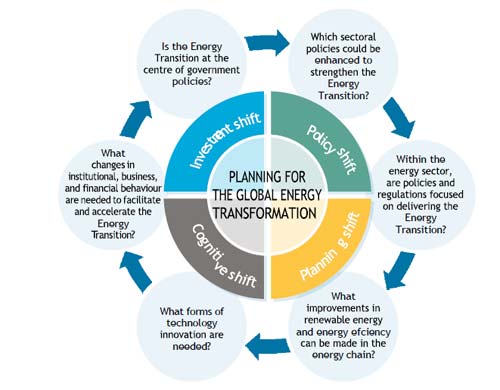| 1. |
Renewable energy needs to be scaled up at least ________ faster for the world to start to meet the goals set out in the Paris Agreement. |
|
|
Six time |
|
|
Ten times |
|
|
Twenty times |
| 2. |
The historic climate accord from 2015 seeks, at minimum, to limit average global temperature rise to "well below _____" in the present century, compared to pre-industrial levels. |
|
|
2°C |
|
|
5°C |
| 3. |
Currently, emission trends are not on track to meet that goal. Government plans still fall far short of emission reduction needs. Under current and planned policies, the world would exhaust its energy-related "carbon budget" (CO2) in under 20 years to keep the global temperate rise to well below 2°C (with 66% probability), while fossil fuels such as oil, natural gas and coal would continue to dominate the global energy mix for decades to come. |
|
|
True |
|
|
False |
| 4. |
According to figure Es2, significant improvement in energy intensity is needed and the share of renewable energy must rise to:
|
|
|
Two-thirds of the current amount |
|
|
Double of the current amount |
| 5. |
Six focus areas where policy and decision makers need to act are:
- Tap into the strong synergies between energy efficiency and renewable energy.
- Plan a power sector for which renewables provide a high share of the energy.
- Increased use of electricity in transport, building and industry.
- Foster system-wide innovation.
- Align socio-economic structures and investment with the transition.
- Ensure that transition costs and benefits are fairly distributed.
|
|
|
True |
|
|
False |
| 6. |
The starting objective of the analysis is to limit the global temperature rise to below 2°C in the present century, with 66% probability. |
|
|
True |
|
|
False |
| 7. |
According to Figure 2. Annual energy-related emissions are expected to remain flat (under current policies in the Reference Case) but must be reduced by over 70% to bring temperature rise to below the 2°C goal. Renewable energy and energy efficiency measures provide over ___ of the reduction required. |
|
|
90% |
|
|
70% |
|
|
50% |
| 8. |
By 2050 in the REmap Case, fossil fuel use for energy would fall to one-third of today’s levels. Oil and coal would decline most, 70% and 85% respectively. Natural gas use would peak around 2027 and would be the largest source of fossil fuel by 2050, however production would decline 30% from the present level. |
|
|
True |
|
|
False |
| 9. |
Figure 7 shows: |
|
|
The declining importance of fossil fuels |
|
|
The declining level of Carbon monoxide in the atmosphere. |
| 10. |
Under the REmap Case, both oil and coal demand decline significantly and continuously, and natural gas demand peaks around 2027. In 2050, natural gas is the largest source of fossil fuel. |
|
|
True |
|
|
False |
| 11. |
Under the REmap Case, emissions in countries fall to between __________ of 2015 levels by 2050. |
|
|
20% and 40% |
|
|
50% and 70% |
|
|
70% and 85% |
| 12. |
The transport sector is dominated by fossil fuels and needs to undergo a profound transformation. |
|
|
True |
|
|
False |
| 13. |
Modern renewable energy in the building sector needs to increase significantly. Up to three-quarters of energy consumption in buildings could be supplied by renewables. Electricity will supply almost ____ of the sector’s energy demand. |
|
|
56% |
|
|
70% |
|
|
85% |
| 14. |
By 2050 renewable energy use in industry needs to grow by ____________. Biomass and renewable electrification will have a prominent role. |
|
|
More than twice the current amount. |
|
|
More than four times |
| 15. |
Figure 30 displays planning for the global energy transformation. According to this figure, planning for the energy transition requires fundamental shifts in policies, investments, planning processes, attitudes and behavior.

|
|
|
True |
|
|
False |
|